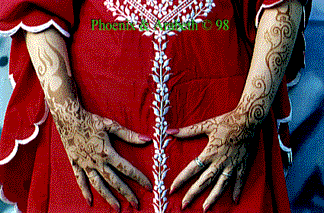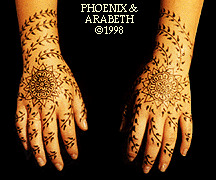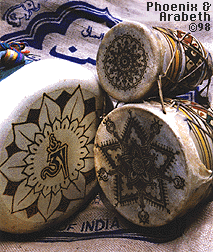contains the latest and most in-depth research into the ancient and venerable history of the art of mehndi. The grasp of ancient history and Asian art is wide-reaching, and his network of archaeologist friends has helped to provide some new finds pertinent to this study. Most of the information, theories and conclusions in The Secret History you will find no where else.
 "Henna has been used extensively in southern China from at least early in the Christian era. In the Nanfang Caomu Zhuang ("Description of Southern Plants) Xi Han (304 AD) says that "...henna was brought to the Southern Seas (SE Asia including the south-easternmost part of China) from Da Qin (Great Qin)." This could mean Rome, Alexandria or Syria, but most likely means the Deccan (western India). Its believed this introduction of the henna plant would have been during the Mauryan Dynasty or the Kushan Dynasty at the latest. It also was imported into China overland from the southwest, i.e., directly from the Middle East/Iranian areas, through Bactria and the Ferghana-Pamirs. It was grown and used extensively in the southern regions which have always been more under the influence of India."
"Henna has been used extensively in southern China from at least early in the Christian era. In the Nanfang Caomu Zhuang ("Description of Southern Plants) Xi Han (304 AD) says that "...henna was brought to the Southern Seas (SE Asia including the south-easternmost part of China) from Da Qin (Great Qin)." This could mean Rome, Alexandria or Syria, but most likely means the Deccan (western India). Its believed this introduction of the henna plant would have been during the Mauryan Dynasty or the Kushan Dynasty at the latest. It also was imported into China overland from the southwest, i.e., directly from the Middle East/Iranian areas, through Bactria and the Ferghana-Pamirs. It was grown and used extensively in the southern regions which have always been more under the influence of India."
 "Henna has been associated with erotic ritual for at least three thousand years, and probably a lot longer." The Secret History shows how this developed, how extensively it was used throughout the ancient Goddess cultures, and where its most ancient form is still practiced today.
"Henna has been associated with erotic ritual for at least three thousand years, and probably a lot longer." The Secret History shows how this developed, how extensively it was used throughout the ancient Goddess cultures, and where its most ancient form is still practiced today.
"The use of henna in the 4th-5th centuries in the Deccan of western India is clearly illustrated on Bodhisattvas and deities of the cave wall murals at Ajanta, and in similar cave paintings on Sri Lanka. The context of these gorgeous murals indicates a ritual use quite sophisticated, and without doubt very ancient. We have already shown how this sacred tradition developed."
"This hard evidence proves henna usage in India seven centuries before the Moghul invasion, and a couple hundred years before the inception of the Islamic religion. There is no doubt the Turkic Moghuls practiced mehndi enthusiastically in the Punjab. They may have adopted the use of mehndi when they were converted to the Muslim religion in Western Turkestan, or they may have taken it up upon their arrival in India. But the ritual use of henna is vastly older than Islam, which began in the mid-7th century AD. It was one of the few ancient Goddess customs which they allowed to continue to exist."
 "Mehndi, or henna painting, is a mysterious and elusive art form. From the deserts of North Africa to Northern villages of India, magnificent designs blossom and vanish upon the hands and feet of women, as they have for thousands of years"
"Mehndi, or henna painting, is a mysterious and elusive art form. From the deserts of North Africa to Northern villages of India, magnificent designs blossom and vanish upon the hands and feet of women, as they have for thousands of years"